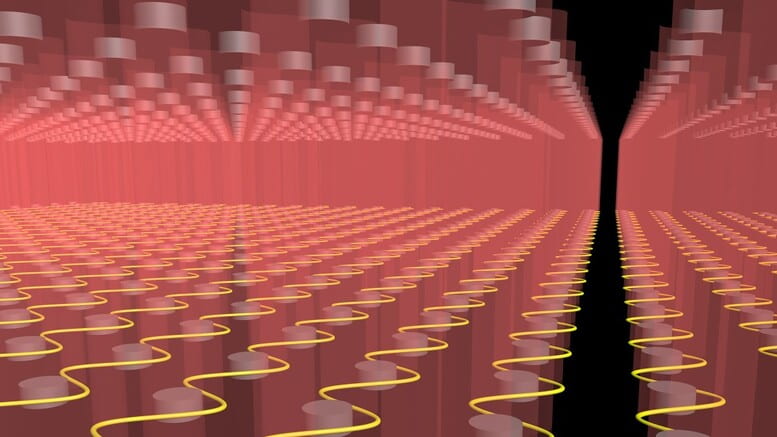Northwestern Chemists Design a New Photonic Lattice with Unprecedented Properties
February 27, 2023

Chemists from Northwestern University have developed a new photonic lattice with properties never before observed in nature. Solid materials require atoms to be spaced equally and close enough together to interact effectively, but the new architectures based on stacked lattices of nanoparticles show interactions across unprecedentedly large distances.
The nanoparticles can interact with each other even when the vertical separation between particles is 1,000 times the distance of the particle-to-particle spacing within the horizontal plane. This ability to communicate across ultralong distances offers potential applications in remote sensing and detection.
Published in the journal Nature Nanotechnology, the study demonstrates that the long-range coupling in the stacked architecture has not been observed before for any stacked periodic material. According to Teri Odom, a senior author of the study and the Joan Hustling Madden and William H. Madden Jr. Professor of Chemistry in the Weinberg College of Arts and Sciences, “This is an entirely new class of engineered materials that have no counterpart or analogue in nature.”
Other Northwestern co-authors include George Schatz, the Charles E. and Emma H. Morrison Professor of Chemistry at Weinberg College.
The stacked architecture of the new photonic lattice could have significant implications for remote sensing and detection in fields such as biology and medicine. It could also lead to advancements in technologies that rely on light, such as solar cells and lasers.
This discovery opens up new avenues for engineering materials with unique properties, and further research could explore the potential of these stacked lattices in a variety of applications. The groundbreaking study demonstrates the potential for groundbreaking advancements in the field of photonics, bringing researchers closer to realizing previously unachievable possibilities.
Science & Technology

Northwestern accelerates quantum research with NVIDIA technology
September 19, 2025
NVIDIA code could help researchers tackle computationally demanding tasks hindering quantum research Northwestern University physicists are using NVIDIA technology to tackle the computationally demanding tasks hindering quantum research. Northwestern theoretical physicist Jens Koch and his research group…

CRISPR’s efficiency triples with DNA-wrapped nanoparticles
September 18, 2025
New system delivers CRISPR machinery more safely and effectively into cells With the power to rewrite the genetic code underlying countless diseases, CRISPR holds immense promise to revolutionize medicine. But until scientists can deliver its…

Passion for the planet: A new generation of environmental stewards starts here
May 29, 2025
Over the last two decades, the Weinberg College-housed Program in Environmental Policy and Culture (EPC) at Northwestern has embraced the humanities and social sciences and cultivated a new generation of environmental stewards. Growing up in…

Northwestern receives $25 million gift to advance adolescent mental health research
May 16, 2025
New institute will study psychology of emerging adults, leading to innovative wellness programming for students at the University and beyond Northwestern University is launching the Institute for Adolescent Mental Health and Well-Being, an interdisciplinary initiative…



